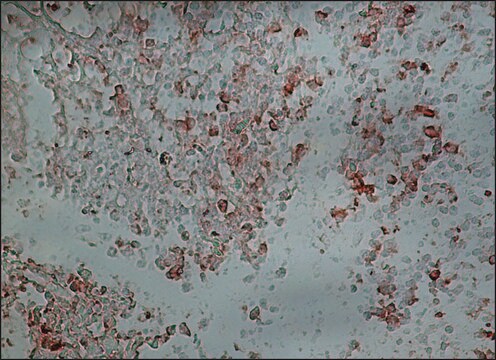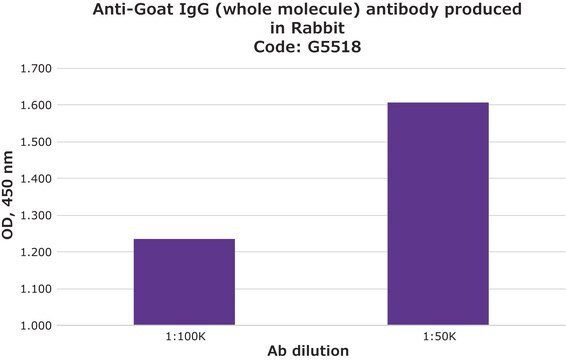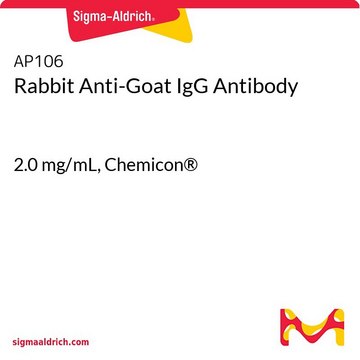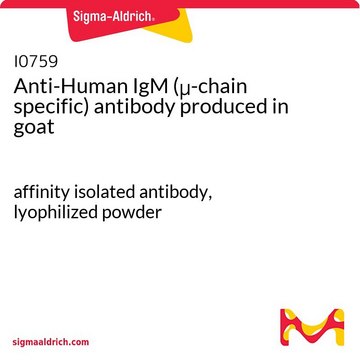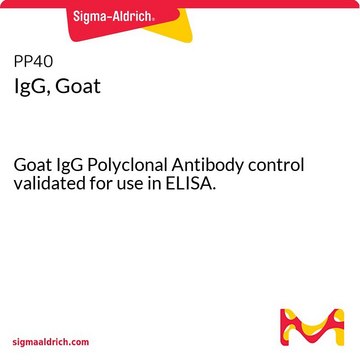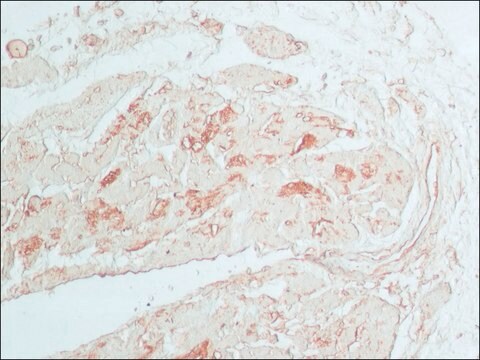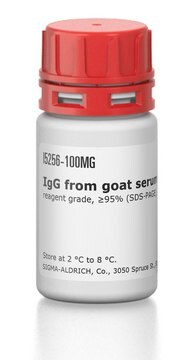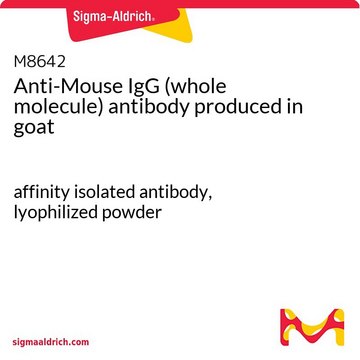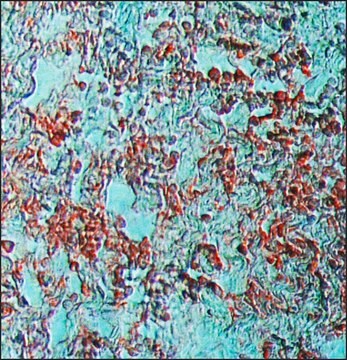G4018
Anti-Goat IgG (whole molecule) antibody produced in rabbit
affinity isolated antibody, buffered aqueous solution
Autenticatiper visualizzare i prezzi riservati alla tua organizzazione & contrattuali
About This Item
Prodotti consigliati
Origine biologica
rabbit
Livello qualitativo
Coniugato
unconjugated
Forma dell’anticorpo
affinity isolated antibody
Tipo di anticorpo
secondary antibodies
Clone
polyclonal
Stato
buffered aqueous solution
tecniche
indirect ELISA: 1:60,000
quantitative precipitin assay: 2.0 mg/mL
Condizioni di spedizione
dry ice
Temperatura di conservazione
−20°C
modifica post-traduzionali bersaglio
unmodified
Cerchi prodotti simili? Visita Guida al confronto tra prodotti
Descrizione generale
IgG is present in large quantities in the human serum. It constitutes about 10-20% of the plasma proteins. IgG is composed of glycoproteins, out of which it is 82-96% proteins and 4-18% carbohydrates. It consists of four sub-classes i.e IgG1, IgG2, IgG3, and IgG4. IgG is composed of four polypeptide chains-two heavy chains (γ chains) and two light chains (κ or λ chains) which are linked by inter-chain disulfide bonds. The heavy chains consist of a N-terminal variable domain (VH) and three constant domains (CH1, CH2, CH3). A hinge region exists between the CH1 and CH2 region. The light chains have one N-terminal variable domain (VL) and one constant domain (CL). The heavy and the light chains are linked at VH and CH1 domain to form the Fab arm (Fragment antigen binding). The antigen binds to the V regions of the antibody.
The product binds to all goat Igs.
Immunogeno
Goat IgG purified from a pool of normal goat serum.
Applicazioni
Anti-Goat IgG (whole molecule) antibody has been used in immunohistochemistry and in lateral flow strips (LF- strips).
Anti-Goat IgG (whole molecule) antibody produced in rabbit was used as control antibody in shear stress experiments conducted on porcine endothelial cells. It was used in ChIP assay to study the H19 imprinting control region in transgenic Drosophila.
Azioni biochim/fisiol
IgG antibody subtype is the most abundant serum immunoglobulin of the immune system. It is secreted by B cells and is found in blood and extracellular fluids and provides protection from infections caused by bacteria, fungi and viruses. Maternal IgG is transferred to fetus through the placenta that is vital for immune defense of the neonate against infections.
IgG, a monoclonal antibody can be cleaved at the hinge region by nonspecific proteases like papain and pepsin. This can result in univalent Fab fragments or bivalent F(ab′)2 fragments. These two enzymes have a broad substrate specificity resulting in heterogenous fragments.
Stato fisico
Solution in 0.01 M phosphate buffered saline, pH 7.4, containing 15 mM sodium azide as preservative.
Nota sulla preparazione
Anti-Goat IgG (whole molecule)is an affinity isolated polyclonal antibody developed in rabbit using goat IgG purified from pooled goat serum as the immunogen. The antibody is purified to remove rabbit serum proteins including immunoglobulins which do not specifically bind to goat IgG.
Risultati analitici
Each milliliter of product contains 2.0-2.5 mg of specific antibody measured by quantitative precipitation. Identity and purity is determined by immunoelectrophoresis(IEP).
Esclusione di responsabilità
Unless otherwise stated in our catalog or other company documentation accompanying the product(s), our products are intended for research use only and are not to be used for any other purpose, which includes but is not limited to, unauthorized commercial uses, in vitro diagnostic uses, ex vivo or in vivo therapeutic uses or any type of consumption or application to humans or animals.
Non trovi il prodotto giusto?
Prova il nostro Motore di ricerca dei prodotti.
Codice della classe di stoccaggio
12 - Non Combustible Liquids
Classe di pericolosità dell'acqua (WGK)
nwg
Punto d’infiammabilità (°F)
Not applicable
Punto d’infiammabilità (°C)
Not applicable
Scegli una delle versioni più recenti:
Possiedi già questo prodotto?
I documenti relativi ai prodotti acquistati recentemente sono disponibili nell’Archivio dei documenti.
I clienti hanno visto anche
Stefan Schoenfelder et al.
EMBO reports, 8(11), 1068-1073 (2007-10-20)
The imprinting control region (ICR) upstream of H19 is the key regulatory element conferring monoallelic expression on H19 and Igf2 (insulin-like growth factor 2). Epigenetic marks in the ICR regulate its interaction with the chromatin protein CCCTC-binding factor and with
Differential expression of RDC1/CXCR7 in the human placenta
Tripathi V, et al.
Journal of clinical immunology, 29(3), 379-379 (2009)
Multi-center evaluation of a user-friendly lateral flow assay to determine IP-10 and CCL4 levels in blood of TB and non-TB cases in Africa
Corstjens P M,et al.
Clinical Biochemistry, 49(1-2), 22-31 (2016)
Márcio Pereira-da-Silva et al.
Endocrinology, 144(11), 4831-4840 (2003-09-10)
Short-term cold exposure of homeothermic animals leads to higher thermogenesis and food consumption accompanied by weight loss. An analysis of cDNA-macroarray was employed to identify candidate mRNA species that encode proteins involved in thermogenic adaptation to cold. A cDNA-macroarray analysis
Chih-Yao Chiang et al.
Thrombosis and haemostasis, 118(11), 1982-1996 (2018-10-10)
Activation of thromboxane A2 synthase (TXAS)/thromboxane A2 (TXA2)/thromboxane prostanoid (TP) receptor leads to arterial constriction, platelet aggregation and vascular injury. We attempted to characterize the microvascular dysfunction in ischaemia/reperfusion injury using genetically modified TXAS-/-, TP-/- and TXAS-/-TP-/- mice. The cardiac
Il team dei nostri ricercatori vanta grande esperienza in tutte le aree della ricerca quali Life Science, scienza dei materiali, sintesi chimica, cromatografia, discipline analitiche, ecc..
Contatta l'Assistenza Tecnica.